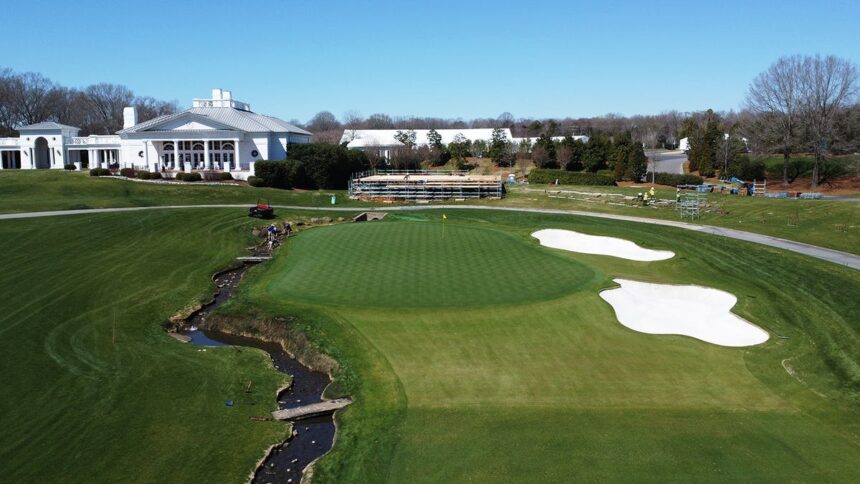As the excitement grows for the 2025 PGA Championship set to unfold at Quail Hollow Club in Charlotte, North Carolina, golf enthusiasts are left pondering a critical question: which hole poses the most difficulty, and which offers the greatest ease? Historical data from past events on this celebrated course provides valuable insights.
Quail Hollow has solidified its reputation in the world of golf, consistently ranking among the top 100 modern courses in the U.S. Notably, this venue was where Justin Thomas triumphed in the 2017 PGA Championship and also served as the stage for the American team’s win at the 2022 Presidents Cup. The club has a long-standing history of hosting PGA Tour events that began in 2003, with earlier competitions taking place from 1969 to 1979 and again from 1983 to 1989 through the PGA Tour Champions series.
Originally designed by George Cobb in 1961, the course has undergone substantial transformations over the decades. Significant adjustments were made by the legendary Arnold Palmer in 1986, followed by a comprehensive redesign led by Tom Fazio, which has crafted its current character.
In preparation for the upcoming championship, Golfweek meticulously examined the scores from the last three PGA Tour events at Quail Hollow. This analysis included the Truist Championship (formerly the Wells Fargo Championship) from 2021, 2023, and 2024, while the tournament was paused in 2022 due to renovations in anticipation of the Presidents Cup.
By assessing the average scores over these recent tournaments and how each hole performed relative to its par, a clear picture emerged. This ranking stretched from the more forgiving holes to those that demand the ultimate skill and precision. History indicates that players should particularly brace themselves for the notoriously challenging final stretch known as the Green Mile, comprising the last three holes.
Quail Hollow No. 15 (ranked 18th most difficult)
Par: 5
Yards: 577
Scoring average: 4.595
Relation to par: -0.405
No. 7 (ranked 17th)
Par: 5
Yards: 546
Scoring average: 4.64
Relation to par: -0.36
No. 10 (ranked 16th)
Par: 5
Yards: 592
Scoring average: 4.676
Relation to par: -0.324
No. 14 (ranked 15th)
Par: 4
Yards: 344
Scoring average: 3.757
Relation to par: -0.243
No. 8 (ranked 14th)
Par: 4
Yards: 346
Scoring average: 3.78
Relation to par: -0.22
No. 4 (ranked 13th)
Par: 3
Yards: 184
Scoring average: 3.007
Relation to par: 0.007
No. 5 (ranked 12th)
Par: 4
Yards: 449
Scoring average: 4.055
Relation to par: 0.055
No. 13 (ranked 11th)
Par: 3
Yards: 205
Scoring average: 3.078
Relation to par: 0.078
No. 2 (ranked 10th)
Par: 4
Yards: 452
Scoring average: 4.157
Relation to par: 0.157
No. 6 (ranked 9th)
Par: 3
Yards: 249
Scoring average: 3.17
Relation to par: 0.17
No. 12 (ranked 8th)
Par: 4
Yards: 456
Scoring average: 4.173
Relation to par: 0.173
No. 3 (ranked 7th)
Par: 4
Yards: 483
Scoring average: 4.185
Relation to par: 0.185
No. 9 (ranked 6th)
Par: 4
Yards: 530
Scoring average: 4.191
Relation to par: 0.191
No. 1 (ranked 5th)
Par: 4
Yards: 505
Scoring average: 4.203
Relation to par: 0.203
No. 11 (ranked 4th)
Par: 4
Yards: 462
Scoring average: 4.214
Relation to par: 0.214
No. 16 (ranked 3rd)
Par: 4
Yards: 529
Scoring average: 4.217
Relation to par: 0.217
No. 17 (ranked 2nd)
Par: 3
Yards: 223
Scoring average: 3.23
Relation to par: 0.23
No. 18 (ranked 1st)
Par: 4
Yards: 494
Scoring average: 4.42
Relation to par: 0.42























